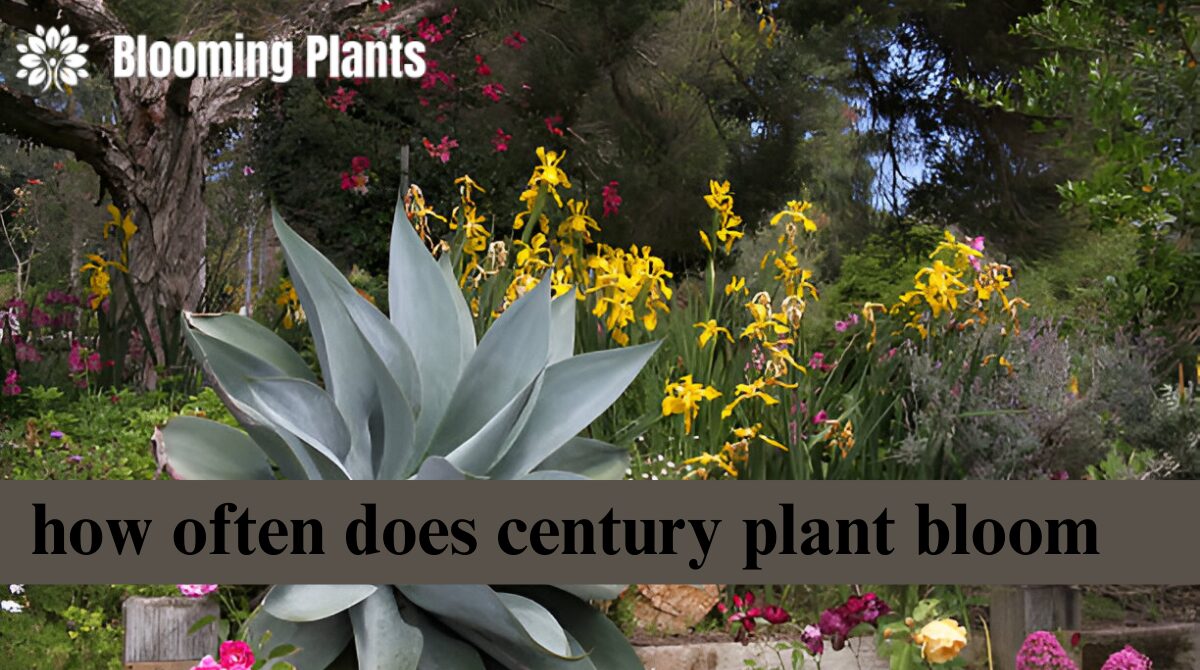The century plant (Agave americana) is a fascinating succulent that has intrigued gardeners and botanists for centuries. Its name suggests that it blooms only once every hundred years, but this is a myth. In reality, the century plant typically flowers once in 10 to 30 years. This dramatic event is a spectacular sight, as the plant produces a towering flower stalk that can reach up to 30 feet tall.
Understanding the blooming cycle of the century plant is essential for those who grow it or admire it in the wild. This article explores how often a century plant blooms, the factors that affect its blooming, and what happens afterward.
Understanding the Century Plant
Botanical Classification and Scientific Name
Scientific Name: Agave americana
Family: Asparagaceae
Genus: Agave
Common Names: Century plant, American aloe (though it’s not a true aloe)
Native Habitat and Growth Conditions
The century plant is native to Mexico but has naturalized in many warm climates worldwide, including the southwestern United States, Mediterranean regions, and parts of Africa. It thrives in:
Arid and semi-arid climates
Well-draining soil
Full sun exposure
Minimal water requirements (drought-tolerant)
Unique Characteristics
Thick, fleshy leaves with sharp spines along the edges
Forms a large rosette that can span 6 to 10 feet wide
It contains a central core where the flower stalk emerges
Monocarpic: Blooms once in its lifetime, then dies
How Often Does a Century Plant Bloom?
The Truth About the Name
Contrary to popular belief, the century plant does not take 100 years to bloom. Instead, it typically flowers between 10 to 30 years, depending on growing conditions.
Factors Influencing Blooming Frequency
Climate: Warmer climates may accelerate blooming, while cooler climates delay it.
Soil Quality: Rich, well-draining soil promotes healthy growth.
Water Availability: Too much water can hinder blooming, while moderate drought conditions may encourage flowering.
Sunlight: The plant requires full sun for optimal growth.
The Blooming Process of a Century Plant
Growth Stages Before Blooming
- Juvenile Stage (0-10 years): The plant establishes itself, growing a large rosette of leaves.
- Mature Stage (10-30 years): The plant continues growing but does not bloom.
- Pre-Bloom Stage: The plant starts showing signs of blooming, such as a swelling center.
- Flowering Stage: A tall flower stalk emerges, growing rapidly within weeks.
Signs of an Impending Bloom
A thick stalk begins forming in the center of the rosette.
Growth accelerates significantly.
Flower buds start developing at the top of the stalk.
Duration of the Blooming Process
Once the flower stalk appears, it can grow up to 6 inches per day and reach full height in a few months. The flowers bloom over a period of several weeks to months before the plant dies.
Environmental Factors Affecting Blooming
Soil Conditions
Ideal Soil: Sandy, well-draining, slightly alkaline
Poor Soil: Clay-heavy, waterlogged soil can delay blooming
Climate and Temperature
Thrives in hot, arid regions with temperatures between 50-85°F.
Cannot survive prolonged frost; cold climates slow growth.
Watering and Maintenance
Minimal watering is best; overwatering leads to rot.
During dry spells, occasional deep watering helps maintain health.
What Happens After a Century Plant Blooms?
The Monocarpic Nature of Agave Americana
Since the century plant is monocarpic, it die after flowering. However, before it dies, it produces seeds and offsets (pups) to ensure survival.
Offsets and Pups
Small plantlets grow around the base of the mother plant.
These can be separated and replanted to continue the plant’s lifecycle.
Harvesting Seeds
The flowers produce thousands of seeds, which can be collected and planted.
How to Care for a Century Plant
Best Soil Conditions
Use a cactus or succulent mix.
Ensure good drainage to prevent root rot.
Sunlight and Watering
Requires full sun exposure.
Water sparingly, allowing the soil to dry out between waterings.
Pest and Disease Management
Watch for agave snout weevils, which burrow into the plant.
Remove dead leaves to prevent fungal infections.
Famous Century Plant Blooms and Case Studies
Notable Blooming Events
| Location | Year | Bloom Height |
| Texas, USA | 2019 | 28 feet |
| Spain | 2021 | 25 feet |
| California, USA | 2023 | 30 feet |
Case Study: Unexpected Blooms in Urban Environments
A century plant in New York City shocked botanists when it bloomed in an indoor greenhouse despite an artificial climate. Researchers studied how temperature and light exposure influenced its blooming cycle.
Century Plant in Landscaping and Gardening
Benefits of Growing a Century Plant
Drought resistance
Low maintenance
Attractive architectural shape
Companion Plants
Yucca
Cactus varieties
Other agaves
Common Myths and Misconceptions
“Does it Really Take 100 Years to Bloom?”
- No, most bloom in 10-30 years.
“Can You Make It Bloom Faster?”
- Not significantly, but optimal care can help.
“What If You Cut the Flower Stalk Early?”
The plant will not bloom again and will still die.
Conclusion
The century plant is a spectacular yet misunderstood succulent. While it doesn’t take a full century to bloom, its rare and magnificent flowering event makes it one of nature’s most fascinating plants. With proper care, gardeners can enjoy this stunning plant for decades before witnessing its final, glorious bloom.
FAQs
How long does a century plant live before blooming?
Typically 10 to 30 years.
What happens after the century plant blooms?
The plant dies but leaves behind offsets.
Can a century plant bloom twice?
No, it is monocarpic and blooms only once.
How tall does the flower stalk grow?
Between 15 to 30 feet.
Can you grow a century plant indoors?
Yes, but it may not reach full size or bloom.
Is the century plant toxic?
Yes, the sap can cause skin irritation.
How do you propagate a century plant?
By seeds or offsets (pups).
Where can I buy a century plant?
Available at nurseries, online stores, and botanical gardens.
Does it require fertilizers?
Not necessarily, but a low-nitrogen fertilizer can boost growth.
Are there different varieties of century plants?
Yes, including variegated forms with unique colors.

